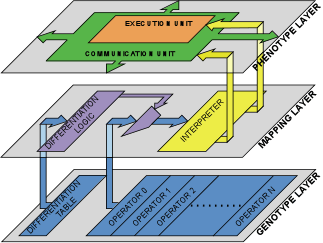Among the many original contributions of the POEtic project, two are particularly relevant for the activities of our group. The first is a definition of the general structure of a processor for bioinspired systems. Such a processor can be seen as a three-layer structure, where each layer is dedicated to the implementation of one of the axes of bio-inspiration. The bottom layer, or genotype layer, stores the genetic information of the cell (the genome). In this layer, the genetic operations associated with evolutionary approaches can be easily implemented, with the aid of an on-chip microcontroller. The middle layer, or mapping layer, implements developmental algorithms to realize processes analogous to ontogenetic growth. The top layer, or phenotype layer, is used for the actual execution of the application. In the case of a POE system, the applications to be executed are based essentially on neural networks, but in theory the architecture is versatile enough to be used for applications that are not directly bio-inspired (in fact, the structure can be adapted to implement any combination of the POE axes).
Obviously, this subdivision is purely logical, as the implementation of the processors on a 2D silicon substrate implies that the three layers are not physically disjoint. Nevertheless, the logical separation can, in many cases, reflect a structural separation of the different units of a processor and we explicitly seek this this property within the cellular processors developed for our projects.
